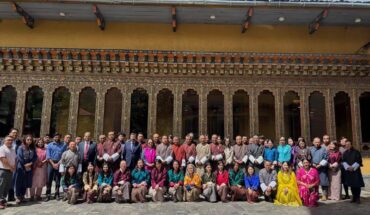
NGAWANG JAMPHEL
Thimphu
With livestock farmers struggling against rising feed costs and increasing production expenses, the Ministry of Agriculture and Livestock (MoAL) has introduced a series of strategic interventions to improve sustainability and ensure national food security.
These measures aim to support smallholder farmers, reduce dependence on imported raw materials, and enhance the viability of Bhutan’s livestock sector in the long run.
At the 13th Meet-the-Press session on March 4, 2025, Agriculture and Livestock Minister Yonten Phuntsho outlined the ministry’s efforts to address these challenges. While acknowledging the financial burden of high feed prices, the minister stated that subsidizing livestock feed was not a viable long-term solution.
Instead, the government is focusing on strengthening domestic feed production, improving livestock nutrition, and ensuring stable market prices to make livestock farming more sustainable.
According to the Integrated Agriculture and Livestock Census 2023, Bhutan has approximately 222,597 cattle, 29,625 pigs, and 819,335 poultry, with the majority owned by smallholder farmers. Livestock farming plays a crucial role in rural livelihoods, but high production costs, particularly for feed, pose a significant challenge.
Bhutan currently has 11 feed mills, but only five—Karma Feed, UDOR, Dhejung, Druko, and Gonor Feeds—are operational. These five mills have a combined production capacity of 514 metric tons (MT) per day, far exceeding the national daily requirement of 72 MT.
However, despite sufficient production capacity, livestock feed remains expensive due to high raw material costs, transportation challenges, and reliance on imports.
Animal feed production in Bhutan depends heavily on imported ingredients such as maize, soybean, rice bran, and wheat bran. Global market fluctuations, currency exchange rates, and logistical hurdles further increase costs, making it difficult for local farmers to afford quality feed.
“The cost of feed is high, and poultry and piggery farms are entirely dependent on concentrated feed. Even if we provide a 30% subsidy for layer poultry alone, it would require Nu 375 million for just one production cycle. A one-time subsidy will not make a significant difference for farmers, so we are focusing on long-term solutions,” Minister Yonten Phuntsho said.
To reduce reliance on imported ingredients, the ministry has initiated pilot projects for local production of alternative feed sources, including cassava and Korean hybrid maize. While these efforts are still in the trial phase, they represent an important step towards strengthening Bhutan’s livestock feed supply.
“We are working towards strengthening domestic feed production, but the reality is that we still depend on imports for essential ingredients like maize, soybean, rice bran, and wheat bran,” Lyonpo Yonten Phuntsho explained. “That’s why, under the 13th Five-Year Plan (FYP), we are prioritizing the production of these raw materials to ensure a stable supply for our feed companies.”
The ministry is also encouraging farmers to cultivate maize, soybean, rice, wheat, quinoa, and peanuts as part of a broader strategy to support domestic feed production. Through the Economic Stimulus Plan (ESP), the government has allocated Nu 500 million under the Price Guarantee Scheme (PGS) to ensure stable market prices for these commodities.
To help dairy farmers cope with high feed costs, the Department of Livestock (DoL) has introduced Total Mixed Ration (TMR), a balanced feed mixture that includes fodder, fresh greens, legumes, and grains. This approach improves cattle nutrition, enhances milk production, and reduces reliance on expensive commercial feed.
In addition, the Bumthang-based feed testing laboratory has been established to ensure the quality and safety of both domestic and imported feeds. By monitoring feed composition and nutritional content, the ministry aims to provide farmers with reliable, high-quality feed options.
Beyond feed production, the government is investing in improved livestock breeding programs to enhance productivity and sustainability. Artificial insemination (AI) services are being expanded, and farmers are being provided with essential inputs such as Day-Old Chicks (DOCs), piglets, and fingerlings.
For pig farming, contract breeders are being supported through a cost-sharing mechanism, ensuring a steady supply of high-quality piglets for farmers. This initiative aims to make pig farming more sustainable while reducing the cost burden on farmers.
To further improve livestock nutrition, the ministry is promoting the cultivation of high-yield fodder grasses, including Tall fescue, Italian rye grass, Clover, Napier-Pakchong, and Guatemala grass. These fodder varieties, which will continue to be distributed under the 13th FYP, provide high nutritional value and can help reduce dependence on commercial feed.
Minister Yonten Phuntsho emphasized that the government’s focus is not just on immediate relief but on creating long-term solutions that will benefit farmers and the entire livestock industry.
“Our goal is to make livestock farming viable for smallholder farmers. By increasing domestic feed production, supporting improved breeding programs, and ensuring price stability, we are working towards a self-sufficient and resilient livestock sector,” he said.
The ministry’s comprehensive approach—ranging from domestic feed production to breeding support and fodder development—is designed to enhance food security, economic stability, and rural livelihoods. With these interventions, Bhutan’s livestock sector is expected to become more self-reliant, ensuring that farmers can sustain their livelihoods despite rising production costs.





